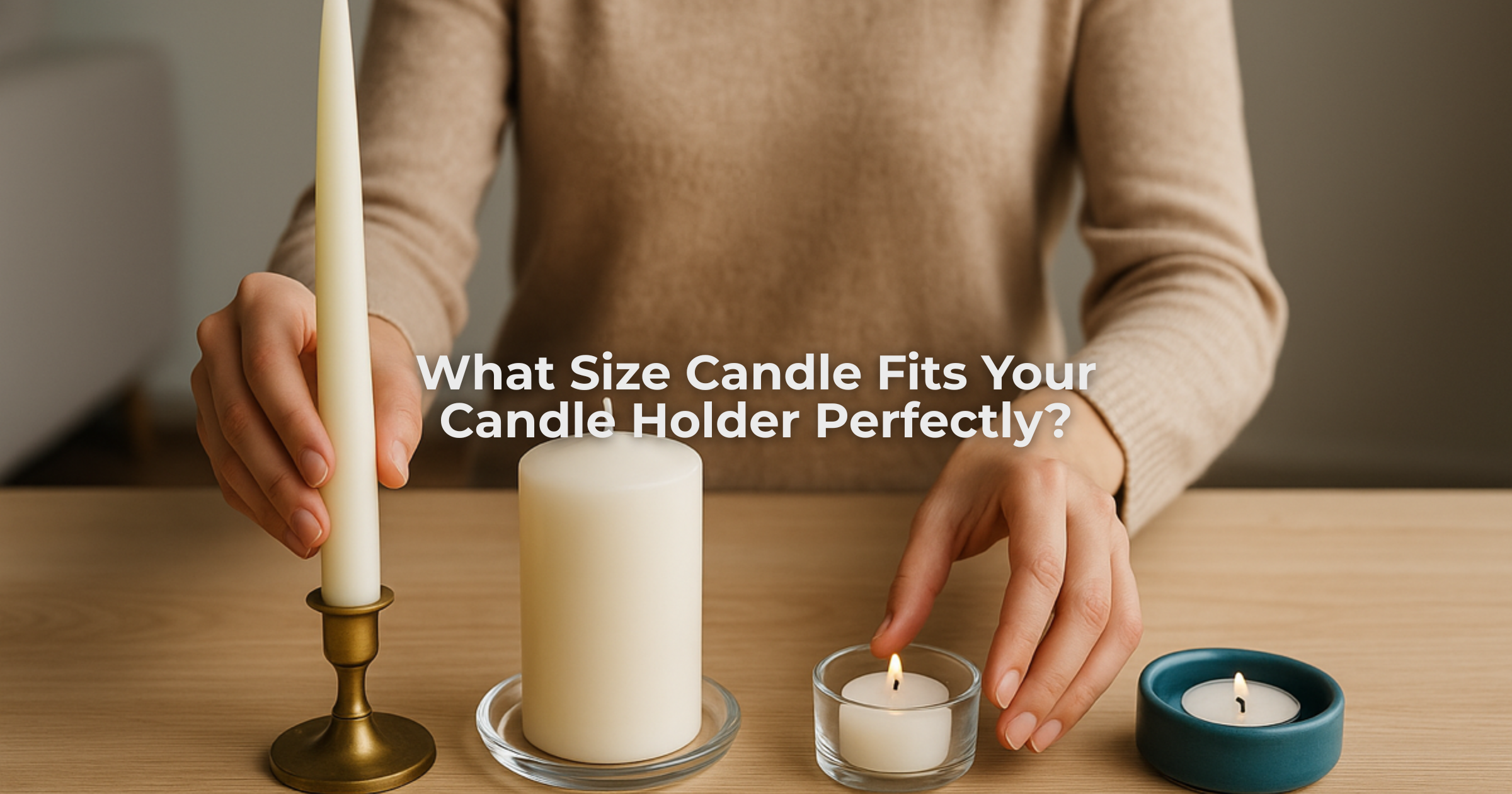No products in the cart.
What Size Candle Fits Your Candle Holder Perfectly?
- karigar
- No Comments

I’ve worked with candles for years, from hand-poured beeswax tapers to custom soy pillars. One thing I’ve learned early on is that the size of your candle isn’t just about aesthetics; it’s about function, stability, and safety.
Many people buy candles that look beautiful but wobble inside the holder or burn unevenly because they don’t fit properly.
If you’ve ever watched wax drip over a tilted taper or seen a pillar drown in melted wax inside a glass jar, you’ve already met the problem this guide solves.
The right candle size for your holder affects burn performance, appearance, and even fragrance throw.
In this article, I’ll explain how to pick the right candle size for any holder, how to measure both, and the small adjustments that make all the difference.
Understanding Candle and Holder Dimensions
Before choosing a candle, you need to measure both the candle’s base diameter and the holder’s inner opening.
I always recommend using a small caliper or measuring tape for accuracy, especially if you’re working with handmade holders that might vary slightly in shape.
Here’s a quick method I use in my studio:
- Measure the candle base diameter across the widest part of the bottom.
- Measure the holder’s inner diameter where the candle will sit.
- Leave a clearance of about 1 to 2 millimeters to allow easy placement and air movement.
This small gap ensures a snug fit without risking cracks or wax overflow. Precision matters more than people realize.
Even a half-millimeter difference can affect burn stability for slender tapers or narrow votives.
Below is a simple reference table I often share with customers:
| Candle Type | Average Diameter | Ideal Holder Opening | Fit Type |
| Taper | ¾ – ⅞ inch | 1 inch | Snug |
| Pillar | 2 – 3 inches | 2.5 – 3.5 inches | Balanced |
| Votive | 1.5 inch | 1.6 inch | Tight |
| Tealight | 1.5 inch | 1.6 inch | Loose |
These dimensions help balance safety, air circulation, and visual proportion.
Candle Types and Their Ideal Holder Sizes
Different candles are made for different candle holders. Knowing their structure helps you pick the right size quickly.
1. Taper Candles
Tapers are elegant and thin, designed for candlesticks or narrow sockets. Their bases usually range between ¾ and ⅞ inch.
If your holder’s opening is slightly wider, you can secure the candle using melted wax drips at the base or a candle adapter ring.
In my workshop, I often test each taper in a few holders before setting it up for display. Precision here makes or breaks presentation quality.
2. Pillar Candles
Pillars are wider, freestanding candles often used with plates, trays, or hurricane holders.
Always ensure the holder is slightly wider than the candle, ideally leaving about 0.25 inches on all sides.
This prevents overheating and allows wax pooling to stabilize. Pillars perform best when air can circulate around them freely.
3. Votive Candles
Votives are short, thick candles that melt completely during use. They must sit in tight glass holders that support the wax pool.
If you use a loose holder, the melted wax spreads and burns unevenly. Choose a glass votive cup only a fraction wider than the candle base.
Tealight Candles
Tealights are small, flat candles enclosed in thin metal or plastic cups. They are standard in diameter, about 1.5 inches, and can fit into almost any tealight holder.
Just ensure the holder is heat-resistant and not fully enclosed, so heat can escape properly.
The holder’s material also affects how well the candle performs. Metal disperses heat quickly, maintaining flame stability.
Glass intensifies warmth and fragrance but needs a wider clearance to prevent cracks. Ceramic provides the most balanced thermal behavior, ideal for long burns or repeated use.
How to Measure and Match a Candle to a Holder
When I make candles for custom holders, I always start by measuring both parts before pouring wax.
This habit saves time and ensures each piece complements the other perfectly. The same approach applies when you’re buying ready-made candles and holders.
Here’s a simple method anyone can follow at home:
- Measure the candle base: Use a ruler or measuring tape across the widest part of the bottom. Note the diameter in inches or millimeters.
- Measure the holder’s inner rim: Measure from one inner edge to the opposite. Be sure to measure the actual space where the candle will sit, not the outer edge.
- Check the clearance: There should be a small space, around 1–2 millimeters, between the candle and the holder wall. This clearance allows for heat expansion and prevents glass cracking.
- Test the fit: Place the candle in the holder before lighting it. A properly sized candle won’t tilt or spin loosely. If it wobbles, try using a wax drip at the base for stability.
If you ever find your candle slightly smaller than the holder, try this tip: soften a little wax and use it to seal the base.
It grips the candle without damaging the holder. Conversely, if your candle is too large, trim or shave the base gently using a paring knife for a better fit.
Precise measurement and testing prevent wax overflow, uneven flames, or even smoke buildup.
Proper sizing also helps the wick perform as intended, giving you longer, cleaner burns.
Final Thoughts
Selecting the right candle size for your holder is all about balance and precision. A well-fitted candle burns evenly, stays stable, and highlights your décor without the mess of wax drips or smoky glass.
Always measure both the candle base and holder opening, allowing a small clearance for airflow and safety.
Through years of candle making, I’ve learned that this simple step, measuring before lighting, changes the entire experience.
It helps the flame burn cleanly, the wax lasts longer, and the room glows with warmth and symmetry.
If you want candles that fit perfectly and perform beautifully, explore Karigar Style’s handcrafted collection.
Each piece is designed for precise fit, long burn time, and effortless elegance so your next lighting moment feels calm, clean, and truly intentional.
Frequently Asked Questions
How can I tell if my candle holder is too big for the candle?
If your candle tilts or spins easily inside the holder, the opening is too wide. You can use melted wax or a candle adapter to stabilize the base, but ideally, choose a holder that’s only a few millimeters wider than the candle.
Does candle height matter when matching it with a holder?
Yes, height affects both balance and burn safety. A candle that’s too tall for a shallow holder may tip over easily. Make sure at least one-third of the candle’s height is supported by the holder.
Can I trim a candle base to make it fit a smaller holder?
You can carefully shave or trim the candle base with a knife to adjust its diameter slightly. Just ensure you keep the cut even so the candle stands straight and burns evenly.
Why do some candles crack the holder while burning?
Cracking usually happens when there’s no clearance for heat expansion or the holder is made of thin glass. Always leave a small air gap and use heat-resistant holders, especially for pillars and enclosed candles.







